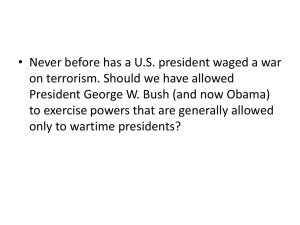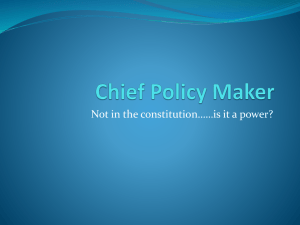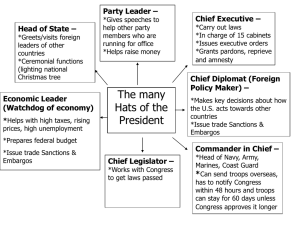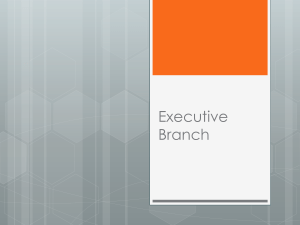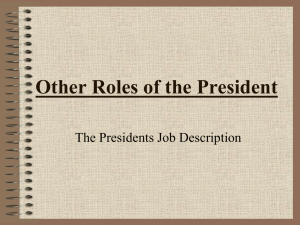The Roles of the President Reading
advertisement
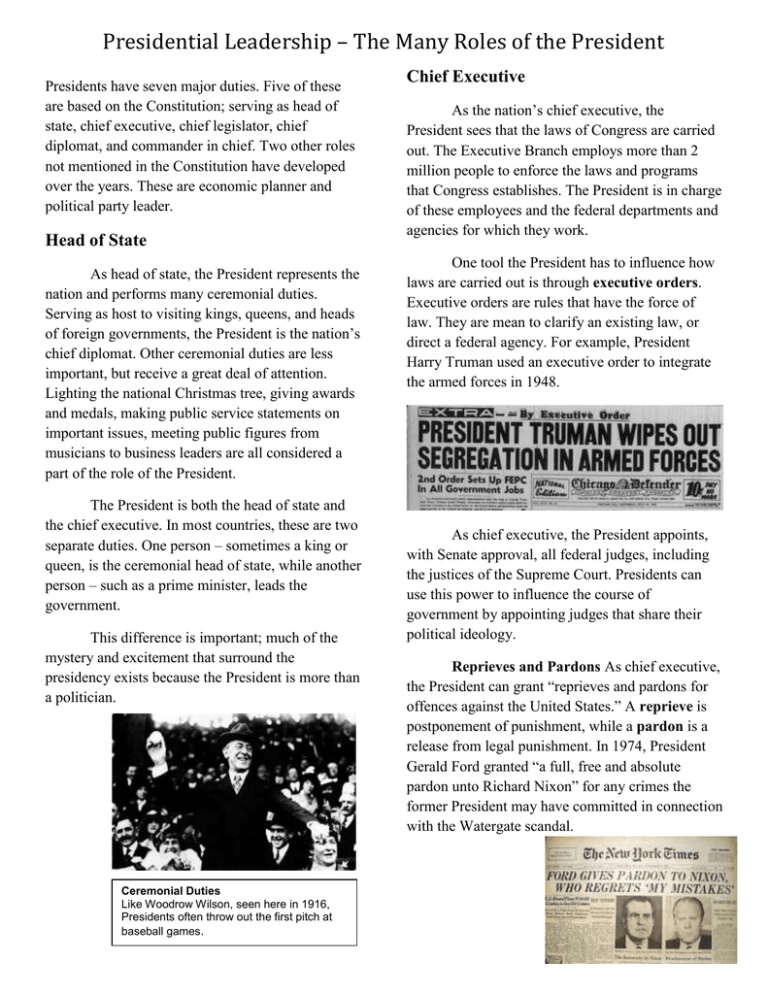
Presidential Leadership – The Many Roles of the President Presidents have seven major duties. Five of these are based on the Constitution; serving as head of state, chief executive, chief legislator, chief diplomat, and commander in chief. Two other roles not mentioned in the Constitution have developed over the years. These are economic planner and political party leader. Head of State As head of state, the President represents the nation and performs many ceremonial duties. Serving as host to visiting kings, queens, and heads of foreign governments, the President is the nation’s chief diplomat. Other ceremonial duties are less important, but receive a great deal of attention. Lighting the national Christmas tree, giving awards and medals, making public service statements on important issues, meeting public figures from musicians to business leaders are all considered a part of the role of the President. The President is both the head of state and the chief executive. In most countries, these are two separate duties. One person – sometimes a king or queen, is the ceremonial head of state, while another person – such as a prime minister, leads the government. This difference is important; much of the mystery and excitement that surround the presidency exists because the President is more than a politician. Ceremonial Duties Like Woodrow Wilson, seen here in 1916, Presidents often throw out the first pitch at baseball games. Chief Executive As the nation’s chief executive, the President sees that the laws of Congress are carried out. The Executive Branch employs more than 2 million people to enforce the laws and programs that Congress establishes. The President is in charge of these employees and the federal departments and agencies for which they work. One tool the President has to influence how laws are carried out is through executive orders. Executive orders are rules that have the force of law. They are mean to clarify an existing law, or direct a federal agency. For example, President Harry Truman used an executive order to integrate the armed forces in 1948. As chief executive, the President appoints, with Senate approval, all federal judges, including the justices of the Supreme Court. Presidents can use this power to influence the course of government by appointing judges that share their political ideology. Reprieves and Pardons As chief executive, the President can grant “reprieves and pardons for offences against the United States.” A reprieve is postponement of punishment, while a pardon is a release from legal punishment. In 1974, President Gerald Ford granted “a full, free and absolute pardon unto Richard Nixon” for any crimes the former President may have committed in connection with the Watergate scandal. Amnesty Finally, the President may also grant amnesty. Amnesty is a group pardon to individuals for an offense against the government. Amnesty often applies to military personnel. For example, Presidents Ford and Carter granted amnesty to men who fled the draft during the Vietnam War. Chief Legislator Congress expects the Executive Branch to propose legislation it wishes to see enacted. Usually, the President describes planned legislative programs in the annual State of the Union message to Congress. This message is meant to call attention to the Presidents ideas about how to solve important problems facing the country. When the President and the majority of Congress are from different political parties, the President must work harder to influence members of Congress to support a particular program. Presidents may hand out political favors to get Congressional support. They may visit the home state of a member of Congress to help support their reelection. Or a President may start a new federal project that will bring money and jobs to a member of Congress’s home state or district. Presidents may also invite members of Congress to important White House social events. An important presidential tool in lawmaking is the veto power. Each bill Congress passes is sent to the President for approval. Presidents sometimes use the threat of a veto to force Congress to stop a bill, or change it to better fit the Presidents wishes. These threats succeed because Congress often finds it difficult to gather the needed 2/3 votes to override a veto. Economic Planner The President’s role as chief economic planner has grown rapidly since Franklin D. Roosevelt’s New Deal. The Employment Act of 1946 gave new duties to the President. This law directed the President to submit an annual economic report to Congress. The President also has the duty to prepare the federal budget every year. The President supervises the work and spends many months with budget officials deciding which programs to support and which to cut back. Party Leader The President’s political party expects the chief executive to be a party leader. The President may give speeches to help fellow party members running for office, or attend fundraising activities to help raise money for the party. Presidents are expected to appoint members of their party to available government jobs. Political patronage, which is the appointment to political office, rewards those who supported the party and President during an election. Being a political party leader can be a difficult role for a President. People expect a President, as head of the government, to represent all Americans. Many Presidents face conflict between leading their own political party and leading the country. Chief Diplomat The President directs the foreign policy of the United States, making decisions about the relations between the United States and other countries. Presidents are given access to classified information about foreign affairs. The Central Intelligence Agency, the State Department the Department of Defense, the Department of Homeland Security and the National Security Council all constantly provide the President with the latest information needed to make foreign policy decisions. Members of Congress, who lack access to that type of information, often find it difficult to challenge the President’s decisions. As chief diplomat, the President has the sole power to make treaties, formal agreements between the governments of two or more countries. As part of the Constitutional system of checks and balances, however, two-thirds of the Senate must approve all treaties before they can go into effect. Generals, admirals and other military leaders run the armed forces on a day-to-day basis. The President, however, is responsible for key military decisions. For example, the President has the authority to order the use of atomic weapons, a tremendous responsibility. The President has other duties as commander in chief. During a war, the President can take actions at home to support a war effort. The President may also use the military within the nation, either to put down rioting or aid in times of natural disasters. Signing a Treaty President Barack Obama in 2011 signs the Strategic Arms Reduction Treaty (START) alongside Russian President Dmitry Medvedev. Commander in Chief Presidents can back up their foreign policy decisions with military force when necessary. The Constitution makes the President commander in chief of the armed forces of the United States. The President shares with Congress the power to make war. Presidents ask for Congressional approval to send troops into battle. The United States has not officially declared war since World War II, despite being involved in numerous conflicts. The War Powers Act of 1973, allows the President to send American troops into combat areas without Congressional approval. Under the act, the President can only send combat troops into battle or into areas where ''imminent'' hostilities are likely, for 60 days without a declaration of war by Congress. The President can extend the time the troops are in the combat area for 30 extra days, without Congressional approval, for a total of 90 days. The act, however, does not specify what Congress can do if the President refuses to comply with the act. Congress could presumably suspend all funds for such troops and override a Presidential veto. The role as head of state, chief legislator, economic planner, chief diplomat, and commander in chief gives the President broad powers. Today, the President of the United States is the most powerful single individual in the world.

